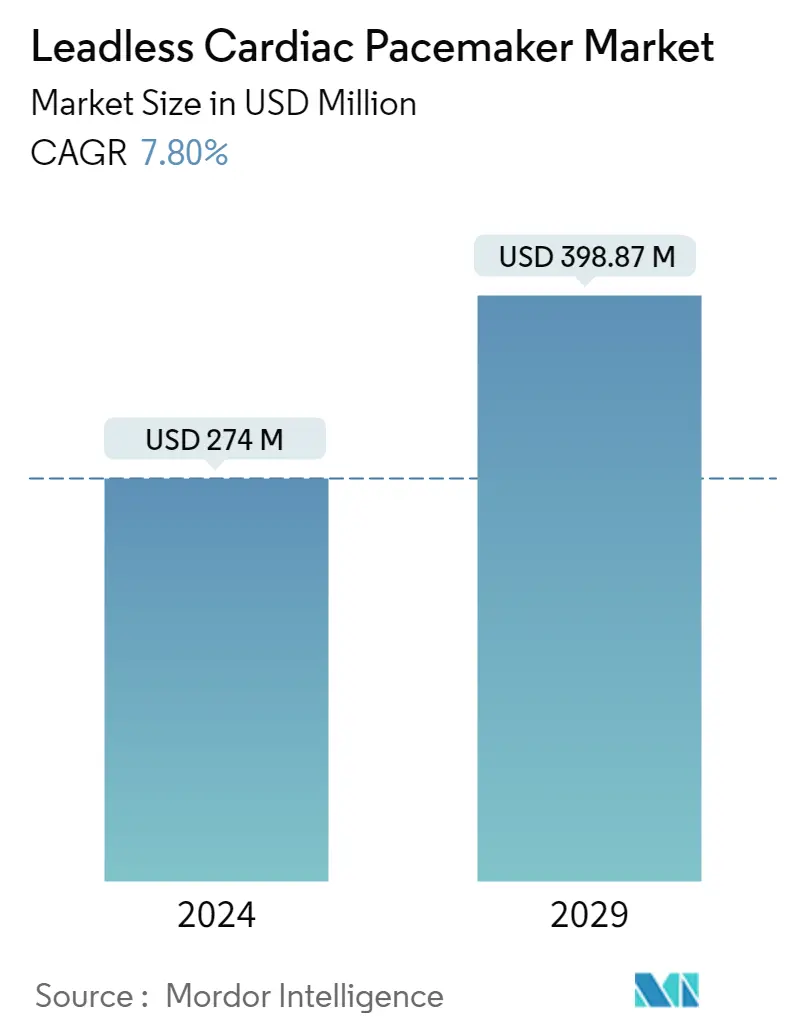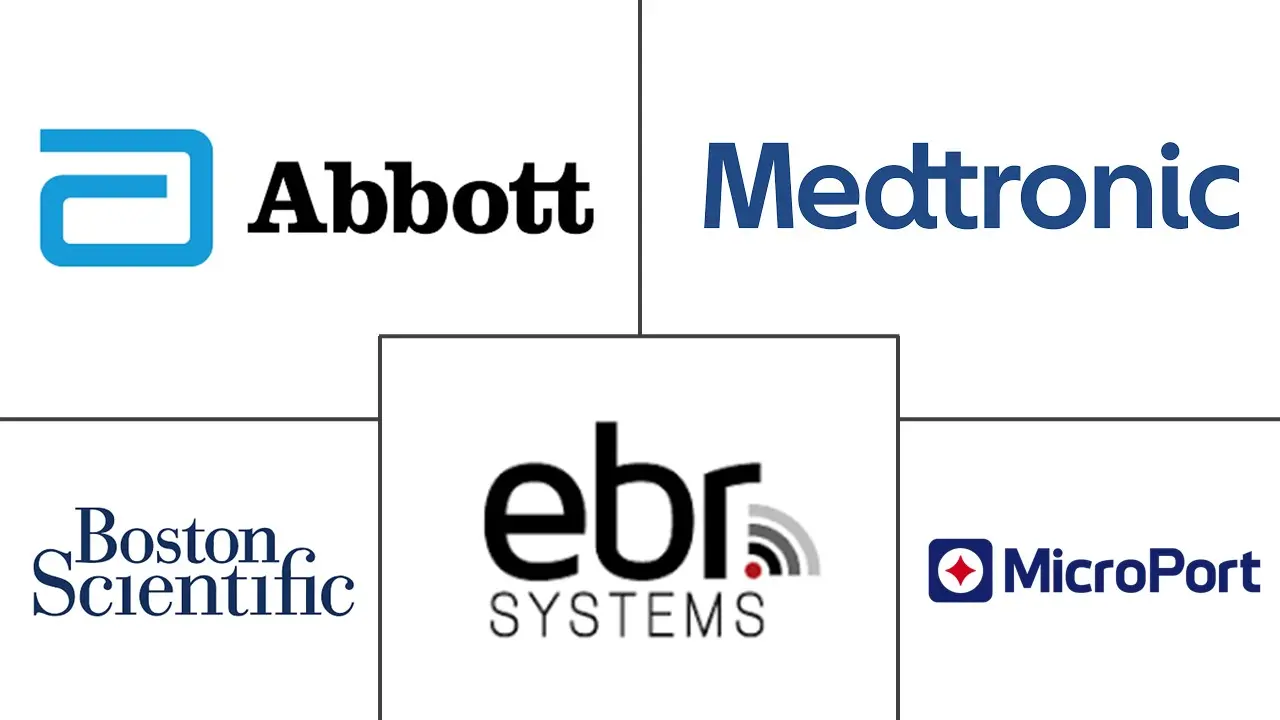Market Size of Leadless Cardiac Pacemaker Industry

| Study Period | 2021 - 2029 |
| Market Size (2024) | USD 274.00 Million |
| Market Size (2029) | USD 398.87 Million |
| CAGR (2024 - 2029) | 7.80 % |
| Fastest Growing Market | North America |
| Largest Market | Asia-Pacific |
Major Players
*Disclaimer: Major Players sorted in no particular order |
Leadless Cardiac Pacemaker Market Analysis
The Leadless Cardiac Pacemaker Market size is estimated at USD 274 million in 2024, and is expected to reach USD 398.87 million by 2029, growing at a CAGR of 7.80% during the forecast period (2024-2029).
The COVID-19 pandemic was an unprecedented health concern and adversely affected various surgical procedures, including cardiac surgery. To minimize the spread of the virus, the government imposed certain regularizations that led to a reduction in surgical procedures. Thus, the reduction of cardiac surgeries led to a decrease in demand for leadless pacemakers initially during the COVID-19 pandemic. An article published in May 2022 by the National Library of Medicine reported that nationally there was a 52.7% reduction in adult cardiac surgery volume and a 65.5% reduction in elective cases. The Mid-Atlantic region was most affected by the first COVID-19 surge, with a 69.7% reduction in overall case volume and an 80.0% reduction in elective cases. Thus, COVID-19 led to a reduction in cardiac surgical procedures, which affected the growth of the studied market. Furthermore, the article published by the National Library of Medicine in February 2022 reported that in North America, 30.7% of the implantations included leadless pacemakers. Thus, with an increased rate of implantation of leadless pacemakers post pandemic as compared to the initial pandemic, the market is expected to regain its growth pace over the coming years.
The rising geriatric population, the growing burden of cardiovascular diseases, and technological advancements are expected to drive the studied market. According to the United Nations' World Population Aging Highlights 2022, there will be 771 million people aged 65 and over in the world in 2022.The older population is projected to reach 994 million by 2030 and 1.6 billion by 2050. As a result, by 2050, there will be more than twice as many people aged 65 and up as children under the age of five.The number of persons aged 65 or over globally will be almost equal to that of those under 12 years of age. Furthermore, an article published by the National Library of Medicine, in December 2021, reported that the incidence of cardiovascular diseases among patients aged 60 to 80 years was on average 75-78%, while in patients over 80 years of age the incidence exceeded 85%. According to the article, age is an unchangeable risk factor that is also considered an independent risk factor for atherogenesis and subsequent cardiovascular disease.Thus, the rising incidence of cardiac disease is driving the growth of the studied market.
An increase in clinical trials of cardiac rhythm implant systems is expected to drive the market. For instance, in December 2021, Boston Scientific launched a clinical trial of its first modular cardiac rhythm implant system. It consists of a leadless pacemaker and an implantable cardioverter defibrillator, two separate devices that aim to work together to keep the heart from beating too fast or too slowly. Such clinical trials are supposed to drive market growth.
Thus, factors such as the rising geriatric population and the growing burden of cardiovascular diseases are impacting the growth of the leadless cardiac pacemaker market. However, reimbursement issues are expected to restrain market growth.
Leadless Cardiac Pacemaker Industry Segmentation
As per the scope of this report, a leadless cardiac pacemaker is a small, self-contained electrode system and generator that is implanted in the right ventricle. The device is placed via a femoral vein transcatheter technique. The Leadless Cardiac Pacemaker Market is segmented By Product (Micra Transcatheter Pacing System, Nanostim Leadless Pacemaker, and Others), End User (Hospitals, Ambulatory Surgical Centers, and Other End Users), and Geography (North America, Europe, Asia-Pacific, Middle East and Africa, and South America). The market report also covers the estimated market sizes and trends for 17 different countries across major regions globally. The report offers the value (in USD million) for the above segments.
| By Product | |
| Micra Transcatheter Pacing System | |
| Nanostim Leadless Pacemaker | |
| Others |
| By End User | |
| Hospitals | |
| Ambulatory Surgical Centers | |
| Other End Users |
| Geography | ||||||||
| ||||||||
| ||||||||
| ||||||||
| ||||||||
|
Leadless Cardiac Pacemaker Market Size Summary
The leadless cardiac pacemaker market is poised for significant growth, driven by factors such as the increasing geriatric population, the rising incidence of cardiovascular diseases, and technological advancements in cardiac care. The market experienced a temporary setback during the COVID-19 pandemic due to a reduction in surgical procedures, which initially decreased the demand for leadless pacemakers. However, the market is expected to regain momentum as the rate of implantation increases post-pandemic. The demand for innovative solutions like the Micra transcatheter pacing system is fueled by its minimal post-implantation complications and ease of retrieval, making it a preferred choice in the management of cardiovascular conditions. The market's expansion is further supported by the high adoption rates of government-approved devices and ongoing clinical trials aimed at enhancing cardiac rhythm management.
North America is anticipated to dominate the leadless cardiac pacemaker market, attributed to the high prevalence of cardiovascular diseases, favorable reimbursement policies, and the presence of major industry players. The region's market growth is bolstered by the increasing number of patients with atrial fibrillation and the successful implementation of clinical trials, such as those conducted by the Cleveland Clinic and Boston Scientific. The competitive landscape is characterized by a few key players, including Abbott Laboratories, Medtronic PLC, and Boston Scientific Corporation, who are actively involved in advancing leadless pacing technology. As these companies continue to innovate and expand their product offerings, the market is expected to experience robust growth throughout the forecast period.
Leadless Cardiac Pacemaker Market Size - Table of Contents
-
1. MARKET DYNAMICS
-
1.1 Market Overview
-
1.2 Market Drivers
-
1.2.1 Rising Geriatric Population
-
1.2.2 Growing Burden of Cardiovascular Diseases
-
1.2.3 Technological Advancements
-
-
1.3 Market Restraints
-
1.3.1 Reimbursement Issues
-
-
1.4 Porter's Five Force Analysis
-
1.4.1 Threat of New Entrants
-
1.4.2 Bargaining Power of Buyers/Consumers
-
1.4.3 Bargaining Power of Suppliers
-
1.4.4 Threat of Substitute Products
-
1.4.5 Intensity of Competitive Rivalry
-
-
-
2. MARKET SEGMENTATION (Market Size by Value - USD million)
-
2.1 By Product
-
2.1.1 Micra Transcatheter Pacing System
-
2.1.2 Nanostim Leadless Pacemaker
-
2.1.3 Others
-
-
2.2 By End User
-
2.2.1 Hospitals
-
2.2.2 Ambulatory Surgical Centers
-
2.2.3 Other End Users
-
-
2.3 Geography
-
2.3.1 North America
-
2.3.1.1 United States
-
2.3.1.2 Canada
-
2.3.1.3 Mexico
-
-
2.3.2 Europe
-
2.3.2.1 Germany
-
2.3.2.2 United Kingdom
-
2.3.2.3 France
-
2.3.2.4 Italy
-
2.3.2.5 Spain
-
2.3.2.6 Rest of Europe
-
-
2.3.3 Asia-Pacific
-
2.3.3.1 China
-
2.3.3.2 Japan
-
2.3.3.3 India
-
2.3.3.4 Australia
-
2.3.3.5 South Korea
-
2.3.3.6 Rest of Asia-Pacific
-
-
2.3.4 Middle East and Africa
-
2.3.4.1 GCC
-
2.3.4.2 South Africa
-
2.3.4.3 Rest of Middle East and Africa
-
-
2.3.5 South America
-
2.3.5.1 Brazil
-
2.3.5.2 Argentina
-
2.3.5.3 Rest of South America
-
-
-
Leadless Cardiac Pacemaker Market Size FAQs
How big is the Leadless Cardiac Pacemaker Market?
The Leadless Cardiac Pacemaker Market size is expected to reach USD 274.00 million in 2024 and grow at a CAGR of 7.80% to reach USD 398.87 million by 2029.
What is the current Leadless Cardiac Pacemaker Market size?
In 2024, the Leadless Cardiac Pacemaker Market size is expected to reach USD 274.00 million.

